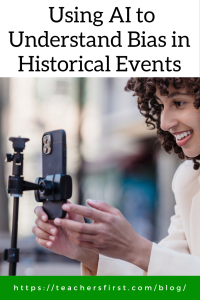Recognizing and analyzing bias is an important skill to teach students. Teaching about bias helps to expand critical thinking skills, develop empathy, and support understanding of diverse viewpoints.
As we learn to use artificial intelligence tools, it is vital to understand that generative tools demonstrate bias in different ways, and we need to look for bias in the results we receive. Bias may appear in many different ways, including cultural bias, confirmation bias, lack of data, etc.
A Cold War Lesson Example: The “Hotline” Establishment
In this video, Lyneth Crighton from Johannesburg, South Africa, demonstrates how to use bias in generative AI to expand student knowledge. In her Cold War lesson for 9th-grade students, she asks her students to use ChatGPT (reviewed here) to generate biased scripts. Students researched Cold War events and created breaking news broadcasts, showcasing how bias shapes how news is delivered.
Let’s adapt Ms. Crighton’s lesson to create a lesson about the August 30, 1963, establishment of the direct line between the United States and the Kremlin, known as the “hotline” or red phone, as a tool for students to understand bias through the use of generative AI. In this lesson, students share breaking news broadcasts as they might look from the US side and the Soviet Union perspective.
- Share articles about the hotline’s establishment, such as this one on History.com and this memorandum available on the US Department of State website, with students and encourage them to look for examples that might show bias. This article from HistorySkills.com provides several suggestions on how to detect bias.
- Assign groups of students to research the hotline from either the United States or the Soviet Union perspective.
- Create a PDF of a Cold War article or website to share with students. If sharing a website, select File>print>Save as PDF.
- If students are thirteen or older, ask them to attach the PDF to a ChatGPT message and ask ChatGPT to rewrite the document to show bias for either the United States or the Soviet Union. If doing a similar activity with younger students, create documents using ChatGPT that demonstrate bias and share them with your students.
- If using other chat generation tools such as Claude (reviewed here) or Perplexity (reviewed here), you might get a message that it won’t create biased documents, especially for educational purposes. As an alternative, instead of asking for a biased viewpoint, ask for information from the Soviet Union or US perspective.
- Encourage students to compare the original document to the biased document and share examples of bias. Use this information to write a script for a one-and-a-half-minute breaking news video broadcast.
- Share a template for students to present news broadcasts, such as this one in Canva for Education (reviewed here). Upload student-created videos into Canva or record directly into the Canva presentation by selecting Uploads>Record Yourself> Camera. This video shares a helpful tutorial for recording in Canva.
- Alternatives to Canva include creating video recordings within Padlet (reviewed here) and adding videos to Google Slides or PowerPoint presentations.
- Provide students with a rubric that shares guidelines for finished projects, including images, videos, and documentation of bias in their text.
Adapting the Lesson for Different Grade Levels
As mentioned, ChatGPT and similar generative tools may not be suitable for all students; however, there are numerous ways to adapt and share materials to begin teaching bias and perspective to all students.
- Elementary School – Use chat tools to create short stories about Christopher Columbus and the First Thanksgiving. A sample prompt is, “ Generate three stories. 1. First, make a short story of the first Thanksgiving from the pilgrim’s point of view. 2. Next, make a short story of the first Thanksgiving from the native Americans’ point of view. 3. The last story combines both points of view.” Ask students to compare and contrast the information in the stories.
- Middle School—Using primary documents, focus on events like the American Revolution or the Civil Rights Movement. For example, when studying the American Revolution, ask students to review primary source documents and explore perspectives from both the colonists’ and loyalists’ points of view.
- High School—Additional topics to explore that may show bias are World War II, the Vietnam War, and the Holocaust. Ask students to analyze speeches from leaders on both sides, watch documentary excerpts, and read articles to find examples of bias.
Visit Project Zero’s Thinking Routines Toolbox (reviewed here) to find many activities that encourage students of all grades to explore information by looking at different viewpoints as they gain essential skills that promote deeper thinking and scaffold learning.
Teaching all students to recognize and analyze bias in any form is a necessary skill. AI tools offer new and exciting opportunities to incorporate technology and historical events to create engaging lessons that develop critical thinking skills and promote a deeper understanding of diverse perspectives. By doing so, we are teaching more than history; we are helping to create a generation of informed, empathetic, and discerning global citizens.


